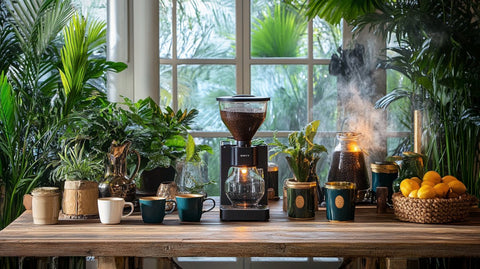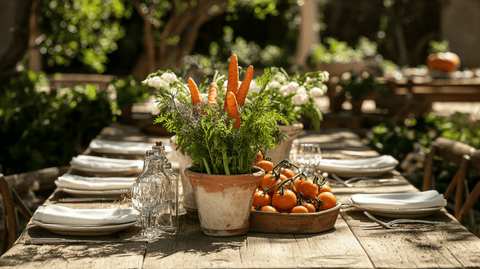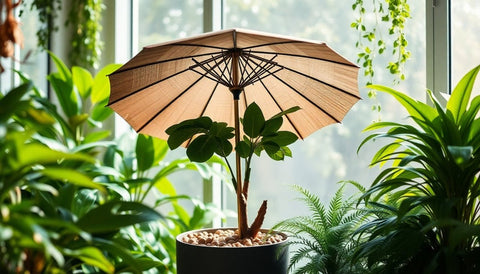Introduction: Discovering the Wonders of Florida Wild Coffee
Embark on a botanical adventure into the heart of Florida's native landscapes, where the lush greenery tells stories of biodiversity and resilience. Among this tapestry of verdant wonders, Florida wild coffee emerges as a captivating specimen, one that combines aesthetic appeal with ecological significance. This introduction dives into the fascinating world of Florida wild coffee (Psychotria nervosa), a plant that not only adds charm to Florida’s flora but also plays a crucial role in its ecosystem.

The Botanical Background of Florida Wild Coffee
Description and Characteristics
Florida wild coffee, known scientifically as Psychotria nervosa, is not your everyday coffee plant. Unlike its globally renowned cousin, this plant isn't valued for its beans but rather for its ornamental qualities and its importance to the local ecosystem. With its glossy leaves, red berries, and dense foliage, wild coffee brings an exotic allure to landscapes.
Morphological Features: Appearance, Size, Leaf Structure
Typically, Florida wild coffee grows to about 4 to 10 feet tall, forming an attractive shrub perfect for tropical and subtropical gardens. Its leaves are elliptical, shiny, and dark green, featuring prominent veins that give it a textured look. The plant is not just about lush greenery; it blooms with small, starry white flowers, which later transform into bright red berries, adding a splash of color to its already striking appearance.
Habitat and Distribution
Thriving in the warm climates of Florida, wild coffee is usually found under the canopy of hardwood forests, hammocks, and coastal areas. It prefers shaded environments and rich, well-drained soils, making it a resilient choice for native plant gardens aimed at conservation and sustainability.
The Ecological Importance of Florida Wild Coffee
Role in Native Ecosystems
Serving as a keystone species, Florida wild coffee provides critical resources for a range of native wildlife. The plant’s berries are a food source for various birds, including cardinals and mockingbirds, while its dense foliage offers shelter and nesting sites.
Attracting Pollinators and Birds
The small, fragrant blooms of wild coffee attract numerous pollinators, including bees and butterflies. This pollinator-friendly nature makes it a cornerstone for ecological gardens designed to promote biodiversity.

Florida Wild Coffee in Landscaping
Design and Aesthetic Appeal
For garden enthusiasts and landscapers, Florida wild coffee provides more than just greenery; it offers a lush, tropical aesthetic that defines many Floridian landscapes. Its adaptability to both formal and informal garden settings makes it a versatile choice for various landscape designs.
The Perfect Pairings: Complementing Other Plants
When planning your garden, consider pairing wild coffee with complementary species to enhance its visual appeal. For instance, the elegant Adonidia palm adds vertical interest, while the striking Blue Agave brings textural contrast.
Planting and Growing Florida Wild Coffee
Soil and Light Preferences
Florida wild coffee thrives in partial to full shade and prefers well-draining, fertile soils. However, it exhibits a remarkable adaptability to different soil types, making it a robust addition to diverse garden environments.
Watering and Fertilization Considerations
Although native to Florida's moist habitats, wild coffee requires moderate watering once established. During dry spells, ensure consistent moisture without waterlogging the soil. Fertilization can be minimal; an organic slow-release fertilizer applied annually will suffice.
Conservation and Environmental Benefits

Contribution to Local Wildlife Conservation
By planting Florida wild coffee, gardeners contribute to wildlife conservation efforts. The plant supports native fauna, establishing habitats that maintain and enhance local biodiversity—a key goal for many environmentally conscious gardeners.
Sustainability Practices in Gardening
Integrating Florida wild coffee into your landscape aligns with sustainable gardening practices, focusing on native plant preservation. When coupled with other native species, such as Alexander Palm or Caribbean Agave, it forms part of a resilient garden ecosystem that minimizes water use and reduces reliance on chemical fertilizers and pesticides.
The Cultural and Historical Significance of Wild Coffee
Historical Uses by Indigenous Peoples
Historically, Indigenous peoples valued Florida wild coffee for its medicinal properties. Its leaves and berries were used in traditional remedies, believed to possess calming and healing effects. Although no longer used for such purposes today, this historical connection adds a layer of cultural depth to this unsuspecting shrub.
The Symbolism in Modern Landscaping
In contemporary landscaping, Florida wild coffee symbolizes environmental stewardship and appreciation for native biodiversity. It stands as a testament to the plant's resilience and adaptability, encouraging gardeners to integrate indigenous plants into modern environments.

Conclusion: Embracing Florida Wild Coffee in Your Garden
Incorporating Florida wild coffee into your landscape not only beautifies your environment but supports ecological balance. By fostering native plant life, you create a harmonious outdoor space that flourishes through sustainable practices and biodiversity enrichment. Discover the joy of bringing a piece of Florida's natural heritage into your garden and inspire a greener future.
Explore Plantology's extensive collection of native plants to complement your Florida wild coffee, from the lush and majestic Adonidia Palm to the elegant Lily of the Nile. Enhance your garden with these perfect plant companions and embark on your sustainable landscaping journey by visiting our website today!
``` ```htmlPropagating Florida Wild Coffee: Tips and Techniques
Understanding Propagation Methods
Propagating Florida wild coffee can be an exciting and rewarding endeavor for gardeners looking to expand their collection or share the beauty of this native plant with others. This section explores the two primary methods of propagation: by seed and by cuttings.
Seed Propagation
Wild coffee seeds are relatively easy to collect and sow. The bright red berries, which are a hallmark of the plant, contain the seeds necessary for propagation. To initiate seed propagation:
- Collect ripe berries when they are bright red and plump.
- Remove the pulp from the seeds by soaking the berries in water for several hours to loosen the flesh. Once the pulp is softened, gently rub the seeds clean.
- Sow the cleaned seeds in a well-draining potting mix, ensuring they are just barely covered.
- Keep the soil consistently moist and place the pots in a shaded area to mimic their natural environment.
- Germination can take several weeks; be patient as the seeds slowly develop into seedlings.
Propagation by Cuttings
Another effective way to propagate Florida wild coffee is through cuttings. This method allows for cloning of the parent plant, preserving its exact characteristics:
- Select healthy, semi-hardwood stems from the plant—ideally, those that are not flowering.
- Cut a 4 to 6-inch stem section just below a node, and remove any leaves from the lower half of the cutting.
- Dip the cut end in rooting hormone to promote root development.
- Plant the cutting in a moist, well-draining potting mix, ensuring at least one node is below the soil level.
- Cover the pot with a plastic bag or a homemade cloche to maintain humidity and warmth.
- Keep the pot in a shaded location, checking regularly to ensure the soil remains damp but not waterlogged.
- After several weeks, once the cutting has established roots, it can be transplanted to a more permanent location.
Pest and Disease Management
Common Pests Affecting Wild Coffee
Though generally resilient, Florida wild coffee may occasionally attract certain pests. Understanding these common threats can help in maintaining the plant’s health and beauty.
Scale Insects: These small, sap-sucking insects can appear as tiny bumps on the plant’s stems and undersides of leaves. Their feeding can cause sooty mold to develop due to honeydew production. Control scale insects by applying horticultural oil or insecticidal soap directly onto the affected areas.
Mealybugs: Mealybugs resemble small cottony masses on the foliage and stems. They can weaken the plant by extracting sap. Introduce natural predators like ladybugs or apply neem oil as a natural pesticide to combat mealybug infestations.
Preventing and Treating Diseases
Disease issues in wild coffee are rare, but occasional problems may arise, necessitating prompt attention to prevent further spread.
Leaf Spot: Leaf spot appears as brown or black lesions on the leaves. It is often a result of fungal or bacterial infections, typically caused by excess moisture or poor airflow. To mitigate leaf spot, remove affected leaves promptly, reduce overhead watering, and ensure adequate spacing for air circulation.
Root Rot: This condition is generally caused by overwatering, leading to waterlogged soil. Symptoms include wilting and yellowing leaves. Cultivate a well-draining soil environment and avoid overwatering to prevent root rot. If root rot is suspected, either reduce watering frequency or transplant the plant to a more adequately draining area.
Enhancing Biodiversity: Florida Wild Coffee in Ecosystem Restoration

Reforestation and Habitat Restoration Projects
Florida wild coffee holds immense value in ecological restoration, serving as a valuable addition to reforestation and habitat rehabilitation efforts. Its adaptability, low maintenance requirements, and ability to thrive in a variety of environmental conditions make it an excellent choice for such projects.
- Soil Stabilization: The dense root structure of wild coffee plays a critical role in preventing soil erosion, especially in areas prone to washout or landslides. Its foliage also contributes to the organic matter on forest floors, enriching the soil quality over time.
- Restoration of Native Fauna: Reintroducing Florida wild coffee into rehabilitated areas aids in attracting local wildlife back to regions impacted by habitat destruction. The plant’s berries serve as a food source for birds, while the lush leaves provide nesting sites and shelter.
Integrative Approaches with Other Native Species
Incorporating Florida wild coffee into multi-species planting schemes can enhance the benefits to local ecosystems. By combining it with other native flora, biodiversity is bolstered, and ecological networks strengthened.
- Synergistic Plant Relationships: Pairing wild coffee with nitrogen-fixing plants, such as Mimosa strigillosa (Sunshine Mimosa), can improve soil fertility naturally, benefiting both wild coffee and surrounding species.
- Pollinator Support: Collaborating with plants like Salvia coccinea (Scarlet Sage) creates a vibrant display that appeals to both pollinating insects and seed-dispersing animals, further enriching the local ecosystem.
Community Engagement and Educational Initiatives
Community Gardens and Public Spaces
Florida wild coffee can serve as a focal point in community gardens and public spaces, fostering both educational opportunities and community involvement in environmental stewardship.
- Workshops and Demonstrations: Host workshops focused on propagating, caring for, and integrating native plants, using wild coffee as a model species. These events enlighten participants about native plant knowledge and sustainable gardening practices.
- Public Planting Days: Organize community planting days where local residents can assist in integrating wild coffee into communal garden spaces, promoting active participation in local ecological conservation efforts.
School Programs and Educational Outreach
Engaging educational programs can use Florida wild coffee as a tool to teach students about local ecology and sustainability. Schools can adopt wild coffee as a part of their outdoor learning environments.
- Hands-On Learning Modules: Develop hands-on science modules that focus on botany, ecology, or environmental science using wild coffee as a demonstrative plant. Such activities can inspire young minds to take an interest in plant biology and conservation.
- Ecological Tours: Conduct guided tours of schools' botanical gardens or local natural reserves, emphasizing the ecological roles and importance of native plants like wild coffee within these natural environments.
Future Perspectives: Sustaining Florida's Natural Heritage
Trends in Native Plant Movement
As awareness of ecological issues grows, so does the movement towards integrating native plants into more traditional gardening and landscaping practices. Florida wild coffee represents a flagship species within this trend, offering insight into broader cultural and ecological shifts.
The native plant movement encourages gardeners to emphasize sustainability and environmental consciousness. As more individuals and organizations begin to appreciate the value of native flora, species like wild coffee become essential components of future-forward, eco-friendly garden designs.
The Role of Florida Wild Coffee in Climate Resilience
In the face of climate change, native plants must withstand shifting weather patterns, from increased temperatures to intensified storms. Florida wild coffee’s resilience to environmental changes underscores its potential role in planting schemes designed to adapt to future climate scenarios.
- Adaptability to Change: By cultivating plants adapted to local climatic conditions, gardeners and landscapers can create resilient landscapes capable of enduring and recovering from extreme weather events more efficiently than non-native plants.
- Carbon Sequestration: Like other dense, bushy perennial plants, wild coffee contributes to carbon capture in small-scale urban greening projects, offsetting emissions via natural means.
Conclusion: A Legacy of Florida Wild Coffee
The exploration of Florida wild coffee demonstrates not only its aesthetic appeal and ecological significance but also its promise for the future. Both an emblem of Florida’s rich natural beauty and a key player in sustainable gardening, wild coffee embodies the essence of balanced gardening practices.
By embracing Florida wild coffee, we take part in a larger effort to preserve ecological integrity and biodiversity within our communities and beyond. This beloved native plant offers endless opportunities for cultural enrichment, educational engagement, and environmental resilience.
Whether as part of a carefully curated garden design or a broader environmental restoration project, Florida wild coffee remains a testament to

































Comments (0)
There are no comments for this article. Be the first one to leave a message!